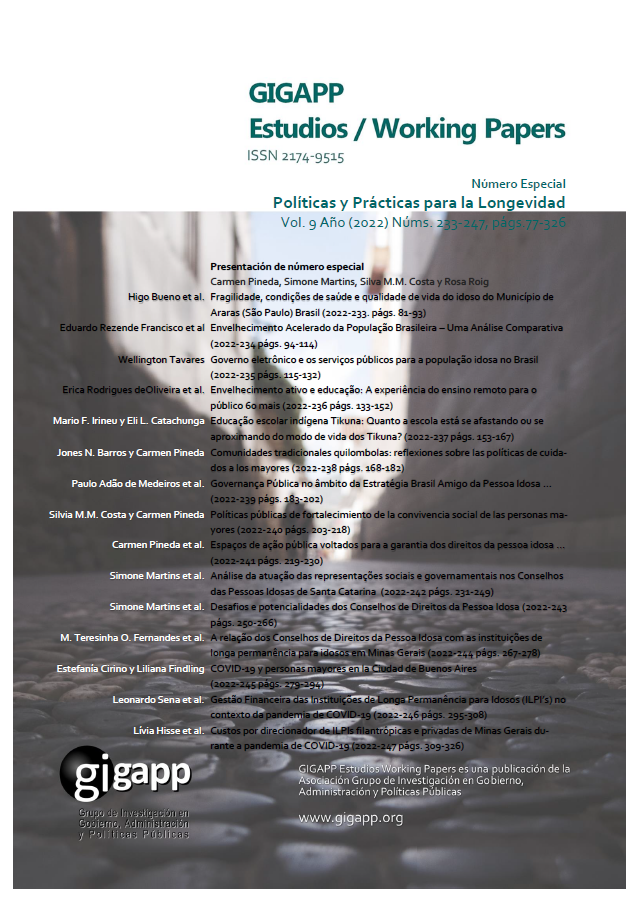Comunidades tradicionales quilombolas
reflexiones sobre las políticas de cuidados a los mayores
Resumen
La población brasileña está envejeciendo. Tal realidad carece de investigaciones que contemplen la temática, especialmente para los PCT, como en el caso de los quilombolas. El Estado de Pará es el cuarto en población quilombola. El artículo tiene como objetivo analizar las políticas de cuidados para esa población, en especial, las personas mayores. Se trata de una investigación cualitativa descriptiva y documental. El examen de los documentos de dominio público: Política Nacional de Salud Integral de la Población Negra, permitió la descripción de la política de cuidados con las personas mayores en el nivel macro (Brasil) y micro (Estado o municipio). Concluyendo que la PNSIPN es una política del SUS – Sistema Único de Salud, sistematizada de forma Tripartita, pero que a partir de 2019 se debilitó por las limitaciones en el presupuesto. La PNSIPN, trata la política de forma genérica. Siendo necesarias estrategias que atiendan de forma específica a la población mayor, y promuevan una longevidad que haga posible envejecer con salud.
Descargas
Citas
Alvarado, A. y Moreno, M. 2007. Adaptación en el envejecimiento. Adaptación y cuidado en el ser hu-mano. Una visión de enfermería. Bogotá: Manual Moderno, Universidad de la Sabana.
Batista, L. E. et al. 2020. Indicadores de monitoramento e avaliação da implementação da Política Nacion-al de Saúde Integral da População Negra. Saúde e Sociedade, v. 29.
Bazo M. 1998. Vejez dependiente, políticas y calidad de vida. Rev Papers 56: 143-61.
Benicio, Rosa T.; Latorre, M. y Ramos L. M. 2003. Determinant factors of functional status among the el-derly. Rev Saude Publica 37: 40-8.
Brasil. 2009.Ministério da Saúde. Portaria nº 992, de 13 de maio de 2009. Institui a Política Nacional de Saúde Integral da População Negra. Diário Oficial da União, Brasília, DF, 14 maio 2009
Brasil. 2011.Ministério da Saúde. Portaria nº 2.866, de 2 de dezembro de 2011. Institui, no âmbito do Sistema Único de Saúde (SUS), a Política Nacional de Saúde Integral das Populações do Campo e da Floresta (PNSIPCF). Diário Oficial da União, Brasília, DF, 5 dez.
Brasil. Ministério da Saúde (MS). 2014. Política Nacional de Promoção da Saúde - PNaPS: revisão da Por-taria MS/ GM nº 687, de 30 de março de 2006. Brasília: MS.
Brasil. https://www.ibge.gov.br/apps/populacao/projecao/index.html
Brasil. https://agenciabrasil.ebc.com.br/geral/noticia/2021-10/populacao-residente-em-area-indigena-e-quilombola-supera-22-milhoes
Cardona D. y Agudelo H. 2006. La Flor de la vida. Pensemos en el adulto. Medellín: Universidad de An-tioquia, Facultad de Salud Pública.
Castillo D. 2009. Envejecimiento exitoso. Rev Med Clin Condes 20: 167-74.
Ebersole, P. y Hess, P. 1994. Toward healthy aging: Human needs and nursing response. 4.ª ed. St. Louis: Mosby-Year Book.
Gómez J. y Curcio C. 2002. Valoración integral del anciano sano. Manizales: Artes Gráficas Tizan.
González-Cuzi, T. 2021. Acompañando el envejecimiento activo y saludable [Webinar]. Universidad Maza Digital.
Guimarães, Nadya Araújo; Hirata, Helena Sumiko e Sugita, Kurumi. 2012. Cuidado e cuidadoras: o trabalho do care no Brasil, França e Japão. In: Hirata, Helena; Guimarães, Nadya Araujo. Cuidado e cuidado-ras: As várias faces do trabalho do care. São Paulo: Atlas.
Küchemann, B. A. 2012. Envelhecimento populacional, cuidado e cidadania: velhos dilemas e novos de-safios. Sociedade e Estado. Brasília: v. 27, n. 1 jan-abr. Disponible en:
Laforest J. 1991. Introducción a la Gerontología. Barcelona: Herder.
Lehr U. 1980. Psicología de la senectud. Barcelona: Herder.
Limón-Mendizábal, M.R. 2018. Envejecimiento activo: un cambio de paradigma sobre el envejecimiento y la vejez. Aula Abierta, 47: 45-54.
Martins, S y Ribeiro, A. Q. 2018. Das Políticas às ações: Direitos da Pessoa Idosa no Brasil. Revista Científi-ca de Direitos Humanos. Brasília, DF, v.1, novembro.
Organización Mundial de la Salud. 2009. Organismos internacionales y envejecimiento. [Internet] [acceso 15 de junio de 2022]. Disponible en: http:// trabal-lo.xunta.es/export/sites/default/Biblioteca/Documentos/Publicacions/congreso_envellecemento/congreso_envejecimiento_activo.pdf
Reyes. RCJ. 2011. El envejecimiento humano activo y saludable, un reto para el anciano, la familia, la so-ciedad. Rev Cubana Invest Bioméd 30: 354-9.
Rowe J. 1987. Human aging: Usual and successful. Science 273: 143-9.
Sartini, C. M. y Correia, A. de M. 2012. Programa Maior Cuidado: qualificando e humanizando o cuidado, Revista Pensar BH 31.
Scheffer, M. et al. 2020. Demografia médica no Brasil 2020. São Paulo: FMUSP, CFM.
Vaillant G. y Mukamal K. 2001. Successful Aging. Am J Psychiatry 158: 839-47.
Yuni, J. y Urbano, C. 2008. Envejecimiento y género: perspectivas teóricas y aproximaciones al envejeci-miento femenino. Revista Argentina de Sociología, 6: 151-169. Recuperado de: http://www.redalyc.org/articulo.oa?id=2696101.
Derechos de autor 2022 Jones Nogueira Barros, Carmen Pineda Nebot (Autor/a)

Esta obra está bajo licencia internacional Creative Commons Reconocimiento-NoComercial-CompartirIgual 4.0.
Aquellos autores/as que tengan publicaciones con esta revista, aceptan los términos siguientes:
a. Los autores/as conservarán sus derechos de autor y garantizarán a la revista el derecho de primera publicación de su obra, el cuál estará simultáneamente sujeto a la Licencia de reconocimiento de Creative Commons Attribution-NonCommercial-ShareAlike 4.0 International (CC BY-NC-SA 4.0) que permite a terceros compartir la obra siempre que se indique su autor y su primera publicación esta revista.
Con esta licencia de acceso abierto, los lectores (usuarios) pueden:
- Compartir — copiar y redistribuir el material en cualquier medio o formato
- Adaptar — remezclar, transformar y construir a partir del material
Bajo los siguientes términos:
-
Atribución — usarios deberán dar crédito de manera adecuada, brindar un enlace a la licencia, e indicar si se han realizado cambios. Puede hacerlo en cualquier forma razonable, pero no de forma tal que sugiera que usted o su uso tienen el apoyo de la licenciante.
-
NoComercial — usuarios no puede hacer uso del material con propósitos comerciales.
-
CompartirIgual — Si remezcla, transforma o crea a partir del material, usuarios deben distribuir su contribución bajo la misma licencia del original.
-
Sin restricciones adicionales: los usuarios no pueden aplicar términos legales o medidas tecnológicas que restrinjan legalmente a otros de hacer cualquier cosa que permita la licencia.
b. Los autores/as podrán adoptar otros acuerdos de licencia no exclusiva de distribución de la versión de la obra publicada (p. ej.: depositarla en un archivo telemático institucional o publicarla en un volumen monográfico) siempre que se indique la publicación inicial en esta revista
c. Se permite y recomienda a los autores/as difundir su obra a través de Internet (p. ej.: en archivos telemáticos institucionales o en su página web) antes y durante el proceso de envío, lo cual puede producir intercambios interesantes y aumentar las citas de la obra publicada. (Véase El efecto del acceso abierto).



